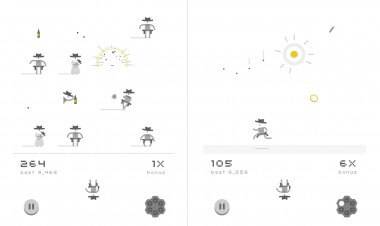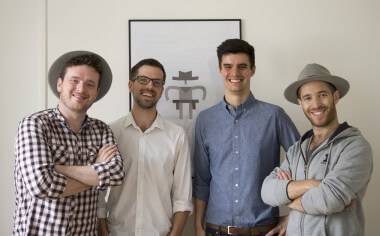The Making of Animade’s ‘Ready Steady Play’
There has been a new addition to the indie game/app market, a sequel to minimalistic and chuckle-worthy Ready Steady Bang. The fast-dueling app with its one or two player options was a hit, tapping well over 1,500,000 downloads. Hover Studio in association with their sister company Animade have now created Ready Steady Play. The game reanimates the little grey cowboy as he takes his hobby horse steed and pistols into three new mini games.
The Wild West-themed gameplay has been developed to incorporate different scenarios; You can test your reflexes in the Shooting Gallery, gunning down a never-ending flow of cowboys; you can steady your steed in the Hobby Hurdles (my personal favorite) or sharpen your aim with the Coin Shooter.
The overall look of the games strip away all unnecessary graphics, leaving the player to enjoy both the simple clean style of the work as well as the incredibly sharp and well observed movement of this singular character. With additional levels promised for future updates, there is nothing to stop you from wiling away many hours on this arcade-like app.
On top of this, as with the previous game the creators of Ready Steady Play have also released a stunning new mini movie to fully immerse the audience into this slick grey, white and yellow world.
Skwigly had the pleasure of talking to Animade and Hover Studio about the creation and vision of their new game.
Could you tell us a little about the relationship between Animade and Hover Studio?
We are essentially one and the same, sharing the studio space and our excellent project management team.
Hover handles the entire web and interactive projects while Animade are responsible for the animation. We are ever increasingly working on projects that span these two areas. And the games are a prime example of these two worlds coming together
The game is a sequel to Ready Steady Bang, which uses the same main character. What inspired the cowboy motif?
Two and a half years ago we sat down for a daytime pint in Hoxton Square to discuss making a short film. We ended up getting very excited about the possibility of making an iOS game. A few drinks later we had settled on the concept of a simple, reaction-based dueling game. We headed back to the studio and jumped straight into designing the cowboy.
We wanted the aesthetic to reflect the simplicity of the game mechanics, so started working up tiny pixel cowboys. It was then a process of sculpting and refining the little fella. We moved away from pixel art to a more stroke based design that makes the cowboy a joy to pose and animate.
How did you go about creating the animation for the character?
For the first game the animation was made frame-by-frame in flash. However, the development of our animation techniques spurred us to start animating the cowboy in after effects. The better interpretation of movement between key frames and the flexibility of shape layers and strokes enabled us to animate so much faster. For example, we started our short film More Than Just a Hobby in Flash. The first 10 seconds must have taken a good week (squeezed around client work) but after a lengthy gap in production we swapped over to AE and finished the remaining 50-60 seconds in about 2 weeks.
The animation in Ready Steady Play also started out in AE. Each sequence of character animation was planned out and split into individual actions; jumps, runs, stumbles, deaths etc. The animation was exported as image sequences and compiled into sprite sheets in another program. It’s amazing how satisfying it is to see every frame of animation layer out on a single page!
How did you find the response to the original game, and what do you expect from the new game?
The first game was a bit of a roller coaster in terms of its reception. We had little idea of how to market an app having never done it before and although we’d made various promo films like 30 Ways the first couple of weeks of downloads were pretty poor. After about a month we started to get reviews from small game and animation blogs. Those small reviews turned into big reviews and we started seeing an impact on the downloads. We thought we were going to be millionaires! After another month however, the daily download rate dropped to a small but steady trickle.
Every now and again we put the game out for free and receive tens of thousands of downloads in a single weekend, which is amazing. It’s lovely to know that so many people are seeing the work we’ve made. Currently the total downloads of Ready Steady Bang stand around 1.5 – 2 million.
It’s hard to tell how good the downloads for Ready Steady Play will be. Obviously we want it to do well and hopefully pay off the time we all put into it. The past week since the game became available has been promising and we’ve even been featured in a couple of countries! When it comes down to it, we’re happy that we’ve made a game we like to play and are proud to share with others.
How would you describe your approach to game design?
With Ready Steady Play we knew that we wanted to make a series of mini-games. Thanks to Ready Steady Bang we already had the theme and aesthetics, so we got to focus more on the individual game mechanics. We started by asking ourselves, “What does a cowboy do?” Looking at our answers we then had to ask, “How can we turn each one into a fun game?” And this is how the first 3 games were spawned.
The first idea that we implemented was Shooting Gallery, where you shoot cowboys until eventually one shoots you. After that we realised that Ready Steady Play was going to be a series of endless games; in theory each one can be played forever. We wanted to make games that really challenged players mechanically and got them completely focused, which would hopefully lead them into that blissful state of “flow”. This took a lot of time, tweaking and playtesting.
We were virtually unlimited with our ideas. So many times we someone would say, “Hey, why don’t we try this?” and suddenly the games would have an extra layer to them. A number of times we’d have to stop ourselves and be critical, and ask the question, “Does this add anything to the game?” For example, we wanted to change up Hobby Hurdles so that he could jump into a mine cart like in the original Donkey Kong Country for SNES. It sounded like a fun idea and very much in tune with the game, but when we realised it really didn’t add to the gameplay we scrapped the idea.
How have you found developing the new game?
The start of development was a challenge as we were trying to choose the system for building the game. Ready Steady Bang was built using cocos2d-iphone, which is a fantastic library for making 2D iOS games. However, we wanted to make the game cross-platform so I started looking into cocos2d-x and Unity. As a 3D engine, Unity turned out to be overly cumbersome for what we were trying to create. cocos2d-x allowed us to get closer to the code so that we could tweak it to work exactly as we wanted. It took some time to set up the game and there was no shortage of challenges, but it made designing a 2D game using only code incredibly easy and flexible.
Working on a long-term project as the sole developer is socially frustrating. So many times I would write some code that (I thought) was brilliant and I wanted to share the breakthrough with someone. I would go to Tom or Ed or anyone unfortunate enough to be nearby and I’d watch their eyes glaze over as they pretended to understand. Suffice it to say, the rest of the company has been very supportive of this endeavor.
Ready Steady Play is now available to buy on iTunes, as well as for android. Visit Animade.tv and HoverStud.io to find out more of their work.



